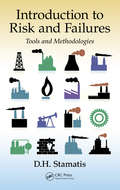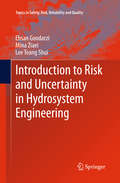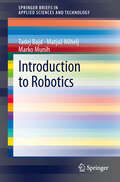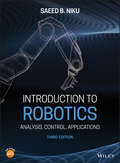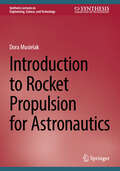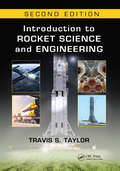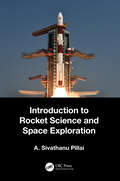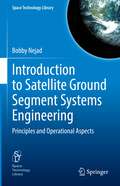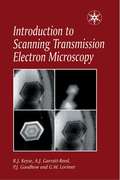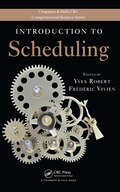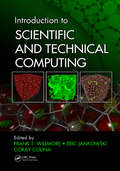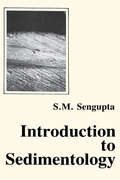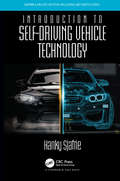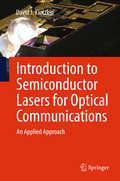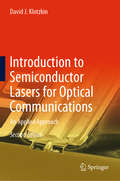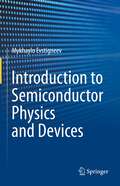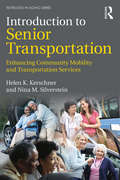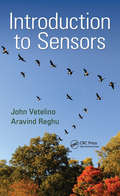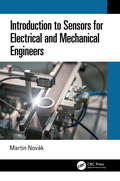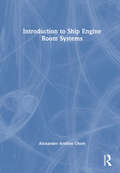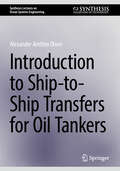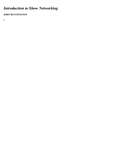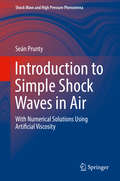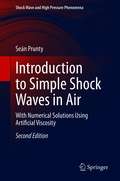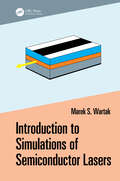- Table View
- List View
Introduction to Risk and Failures: Tools and Methodologies
by D. H. StamatisRisk is everywhere, in everything we do. Realizing this fact, we all must try to understand this "risk" and if possible to minimize it. This book expands the conversation beyond failure mode and effects analysis (FMEA) techniques. While FMEA is indeed a powerful tool to forecast failures for both design and processes, it is missing methods for considering safety issues, catastrophic events, and their consequences. This new book focuses on risk and HAZOP as they relate to major catastrophic events, safety, and risk.
Introduction to Risk and Uncertainty in Hydrosystem Engineering
by Ehsan Goodarzi Mina Ziaei Lee Teang ShuiWater engineers require knowledge of stochastic, frequency concepts, uncertainty analysis, risk assessment, and the processes that predict unexpected events. This book presents the basics of stochastic, risk and uncertainty analysis, and random sampling techniques in conjunction with straightforward examples which are solved step by step. In addition, appropriate Excel functions are included as an alternative to solve the examples, and two real case studies is presented in the last chapters of book.
Introduction to Robotics
by Marko Munih Matjaž Mihelj Tadej BajdThis book is focused on geometrical models of robot mechanisms. Rotation and orientation of an object are described by Rodrigues's formula, rotation matrix and quaternions. Pose and displacement of an object are mathematically dealt with homogenous transformation matrices. The geometrical robot model is based on Denavit Hartenberg parameters. Direct and inverse model of six degrees of freedom anthropomorphic industrial robots are also presented.
Introduction to Robotics: Analysis, Control, Applications
by Saeed B. NikuThe revised text to the analysis, control, and applications of robotics The revised and updated third edition of Introduction to Robotics: Analysis, Control, Applications, offers a guide to the fundamentals of robotics, robot components and subsystems and applications. The author—a noted expert on the topic—covers the mechanics and kinematics of serial and parallel robots, both with the Denavit-Hartenberg approach as well as screw-based mechanics. In addition, the text contains information on microprocessor applications, control systems, vision systems, sensors, and actuators. Introduction to Robotics gives engineering students and practicing engineers the information needed to design a robot, to integrate a robot in appropriate applications, or to analyze a robot. The updated third edition contains many new subjects and the content has been streamlined throughout the text. The new edition includes two completely new chapters on screw-based mechanics and parallel robots. The book is filled with many new illustrative examples and includes homework problems designed to enhance learning. This important text: Offers a revised and updated guide to the fundamental of robotics Contains information on robot components, robot characteristics, robot languages, and robotic applications Covers the kinematics of serial robots with Denavit-Hartenberg methodology and screw-based mechanics Includes the fundamentals of control engineering, including analysis and design tools Discusses kinematics of parallel robots Written for students of engineering as well as practicing engineers, Introduction to Robotics, Third Edition reviews the basics of robotics, robot components and subsystems, applications, and has been revised to include the most recent developments in the field.
Introduction to Rocket Propulsion for Astronautics (Synthesis Lectures on Engineering, Science, and Technology)
by Dora MusielakThis book discusses the basic principles, performance, and technologies unique to the propulsion systems that power space vehicles. It is intended as a stimulating and accessible way in to the subject, aiming for a clear understanding of basic principles, providing a description of propulsion key physical mechanisms, and emphasizing the current state of technologies for the different applications such as launch vehicles, and space probes. The seven chapters comprise the wide scope of space rocket propulsion, filtered to highlight the main ideas without sacrificing the most important results.
Introduction to Rocket Science and Engineering (Second Edition)
by Travis S. TaylorIntroduction to Rocket Science and Engineering, Second Edition, presents the history and basics of rocket science, and examines design, experimentation, testing, and applications. Exploring how rockets work, the book covers the concepts of thrust, momentum, impulse, and the rocket equation, along with the rocket engine, its components, and the physics involved in the generation of the propulsive force. The text also presents several different types of rocket engines and discusses the testing of rocket components, subsystems, systems, and complete products. The final chapter stresses the importance for rocket scientists and engineers to creatively deal with the complexities of rocketry.
Introduction to Rocket Science and Space Exploration
by A. Sivathanu PillaiThe growing demand of space services for imaging, mobile communication, global positioning systems and disaster management, life extension of satellites by fueling, space station operations, deflecting incoming asteroids, and reducing debris from orbits, requires reusable rockets. The chapters in the book cover understanding of the universe, history of rockets, space missions, satellites, the principle of rocketry, its design and development, rocket technology, the solar system, the environment and protection of earth, and thoughts on Earth 2.0. Features: Explores the link between universe, space exploration, and rocketry. Discusses topics such as protection of the Earth from asteroids, debris, and global warming. Includes basic methodology to be adopted to design rockets for various applications. Covers use of multi-objective optimisation to realise a system and differences in design philosophies for satellite launch. Examines material on environmental protection of the Earth. This book is aimed at senior undergraduates and professionals in aerospace engineering.
Introduction to Satellite Ground Segment Systems Engineering: Principles and Operational Aspects (Space Technology Library #41)
by Bobby NejadThe ground segment is the fundamental backbone of every satellite project, yet it is usually not visible to the public or the end user of a satellite service. Also the bulk of existing published space literature tends to focus on the satellite or its subsystems. This book tries to fill this gap and addresses systems engineering concepts applied to the design, development, qualification, and deployment of the ground control segment required to operate a single satellite, a constellation, or even a manned space vehicle. The domain of ground segment engineering has significantly evolved in recent years, mainly driven by major advances in the IT sector. Hardware virtualisation or the availability of on-demand cloud computing services are typical examples of new technologies that have changed fundamental architectural concepts previously standard in heritage ground segments. Furthermore, the stark increase of cyber attacks - today a major risk to almost all critical IT based infrastructure - has made a cyber threat resilient architecture to become one of the indispensable design requirements for ground segment engineers. The new mega constellations recently put into space deploying up to several hundred of flying objects have put very demanding needs on the ground segment for automated satellite operations. These topics and more are addressed in the book’s chapters, along with a detailed explanation of the most relevant components of a typical ground segment architecture. The basic functional requirements, design features, and the most important ground and space segment interfaces are addressed and explained in detail, supported by a wealth of figures for easier understanding. This book is kept at an introductory level, allowing newcomers to get familiar with this fairly complex subject matter. It is therefore suitable for graduate students, but can equally serve as a valuable source of information for already experienced space engineers who seek to gain a deeper understanding of the ground segment infrastructure and related systems engineering processes. It can also help project managers to better interact with their systems engineers, satellite developers to define their ground segment interfaces, and satellite operators to improve their flight and ground procedures. It is very well suited for everyone intending to start a career in satellite ground segment systems engineering.
Introduction to Scanning Transmission Electron Microscopy
by Dr Robert Keyse1997 was the 'Year of the Electron' because it marked the centenary pf the celebrated discovery of the smallest of the fundamental particles that make up ordinary matter, and which has proved to have so many remarkable properties that, after light, it has become the most widley used of the particles in scientific and technogical applications. STEM is a discipline of importance to a growing number of microscopists. This book is essential reading for undergraduates, postgraduates and researchers requiring an up-to-date and comprehensive introduction to this rapidly growing, state of the art technique.
Introduction to Scheduling (Chapman & Hall/CRC Computational Science)
by Yves Robert Frédéric VivienFull of practical examples, Introduction to Scheduling presents the basic concepts and methods, fundamental results, and recent developments of scheduling theory. With contributions from highly respected experts, it provides self-contained, easy-to-follow, yet rigorous presentations of the material.The book first classifies scheduling problems and
Introduction to Scientific and Technical Computing
by FRANK T. WILLMORE, ERIC JANKOWSKI AND CORAY COLINACreated to help scientists and engineers write computer code, this practical book addresses the important tools and techniques that are necessary for scientific computing, but which are not yet commonplace in science and engineering curricula. This book contains chapters summarizing the most important topics that computational researchers need to know about. It leverages the viewpoints of passionate experts involved with scientific computing courses around the globe and aims to be a starting point for new computational scientists and a reference for the experienced. Each contributed chapter focuses on a specific tool or skill, providing the content needed to provide a working knowledge of the topic in about one day. While many individual books on specific computing topics exist, none is explicitly focused on getting technical professionals and students up and running immediately across a variety of computational areas.
Introduction to Sedimentology
by Supriya SenguptaA concise account of all major branches of sedimentary geology, highlighting the connecting links between them. Introduction; Processes of sedimentation; Sedimentary texture; Sedimentary petrology; Hydraulics, sediment transportation and structures of mechanical origin; Sedimentary environments and facies; Tectonics and sedimentation; Stratigraphy and sedimentation; Basin analysis: A synthesis; References; Index.
Introduction to Self-Driving Vehicle Technology (Chapman & Hall/CRC Artificial Intelligence and Robotics Series)
by Hanky SjafrieThis book aims to teach the core concepts that make Self-driving vehicles (SDVs) possible. It is aimed at people who want to get their teeth into self-driving vehicle technology, by providing genuine technical insights where other books just skim the surface. The book tackles everything from sensors and perception to functional safety and cybersecurity. It also passes on some practical know-how and discusses concrete SDV applications, along with a discussion of where this technology is heading. It will serve as a good starting point for software developers or professional engineers who are eager to pursue a career in this exciting field and want to learn more about the basics of SDV algorithms. Likewise, academic researchers, technology enthusiasts, and journalists will also find the book useful. Key Features: Offers a comprehensive technological walk-through of what really matters in SDV development: from hardware, software, to functional safety and cybersecurity Written by an active practitioner with extensive experience in series development and research in the fields of Advanced Driver Assistance Systems (ADAS) and Autonomous Driving Covers theoretical fundamentals of state-of-the-art SLAM, multi-sensor data fusion, and other SDV algorithms. Includes practical information and hands-on material with Robot Operating System (ROS) and Open Source Car Control (OSCC). Provides an overview of the strategies, trends, and applications which companies are pursuing in this field at present as well as other technical insights from the industry.
Introduction to Semiconductor Lasers for Optical Communications
by David J. KlotzkinThis textbook provides a thorough and accessible treatment of semiconductor lasers from a design and engineering perspective. It includes both the physics of devices as well as the engineering, designing and testing of practical lasers. The material is presented clearly with many examples provided. Readers of the book will come to understand the finer aspects of the theory, design, fabrication and test of these devices and have an excellent background for further study of optoelectronics. This book also: Provides a multi-faceted approach to explaining the theories behind semiconductor lasers, utilizing mathematical examples, illustrations and written theoretical presentations Offers a balance of relevant optoelectronic topics, with specific attention given to distributed feedback lasers, growth techniques and waveguide cavity design Provides a summary of every chapter, worked examples, and problems for readers to solve Incorporates and explains recent breakthroughs in laser design
Introduction to Semiconductor Lasers for Optical Communications: An Applied Approach
by David J. KlotzkinThis updated, second edition textbook provides a thorough and accessible treatment of semiconductor lasers from a design and engineering perspective. It includes both the physics of devices as well as the engineering, designing and testing of practical lasers. The material is presented clearly with many examples provided. Readers of the book will come to understand the finer aspects of the theory, design, fabrication and test of these devices and have an excellent background for further study of optoelectronics.
Introduction to Semiconductor Physics and Devices
by Mykhaylo EvstigneevThis classroom-tested textbook provides a self-contained one-semester course in semiconductor physics and devices that is ideal preparation for students to enter burgeoning quantum industries. Unlike other textbooks on semiconductor device physics, it provides a brief but comprehensive introduction to quantum physics and statistical physics, with derivations and explanations of the key facts that are suitable for second-year undergraduates, rather than simply postulating the main results. The book is structured into three parts, each of which can be covered in around ten lectures. The first part covers fundamental background material such as quantum and statistical physics, and elements of crystallography and band theory of solids. Since this provides a vital foundation for the rest of the text, concepts are explained and derived in more detail than in comparable texts. For example, the concepts of measurement and collapse of the wave function, which are typically omitted, are presented in this text in language accessible to second-year students. The second part covers semiconductors in and out of equilibrium, and gives details which are not commonly presented, such as a derivation of the density of states using dimensional analysis, and calculation of the concentration of ionized impurities from the grand canonical distribution. Special attention is paid to the solution of Poisson’s equation, a topic that is feared by many undergraduates but is brought back down to earth by techniques and analogies from first-year physics. Finally, in the third part, the material in parts 2 and 3 is applied to describe simple semiconductor devices, including the MOSFET, the Schottky and PN-junction diodes, and optoelectronic devices. With a wide range of exercises, this textbook is readily adoptable for an undergraduate course on semiconductor physics devices, and with its emphasis on consolidating and applying knowledge of fundamental physics, it will leave students in engineering and the physical sciences well prepared for a future where quantum industries proliferate.
Introduction to Senior Transportation: Enhancing Community Mobility and Transportation Services (Textbooks in Aging)
by Helen K. Kerschner Nina M. SilversteinIntroduction to Senior Transportation focuses on an issue that is a growing concern—the community mobility needs of older adults. Surpassing the coverage available in existing gerontology textbooks, it enables the reader to understand and appreciate the challenges faced by older adults as they make the transition from driving to using transportation options (many of which were not designed to meet their particular needs). It considers the physical and cognitive limitations of older adult passengers, the family of transportation services, the challenges providers face in meeting the assistance and support needs of senior passengers, and the transportation methods that do and do not currently meet the needs and wants of senior passengers. This textbook addresses the educational and professional development needs of faculty, students, and practitioners working in the fields of aging, aging services, and transportation. The book has been class-tested and features innovative, practical learning tools that appeal to students and practitioners. It complements any introductory course in gerontology, human development and aging, or human factors, and will enhance the curriculum of programs in the social behavioral sciences as well as traffic safety, transit engineering, and community planning.
Introduction to Sensors
by John Vetelino Aravind ReghuThe need for new types of sensors is more critical than ever. This is due to the emergence of increasingly complex technologies, health and security concerns of a burgeoning world population, and the emergence of terrorist activities, among other factors. Depending on their application, the design, fabrication, testing, and use of sensors, all require various kinds of both technical and nontechnical expertise. With this in mind, Introduction to Sensors examines the theoretical foundations and practical applications of electrochemical, piezoelectric, fiber optic, thermal, and magnetic sensors and their use in the modern era. Incorporating information from sensor-based industries to review current developments in the field, this book: Presents a complete sensor system that includes the preparation phase, the sensing element and platform, and appropriate electronics resulting in a digital readout Discusses solid-state electronic sensors, such as the metal oxide semiconductor (MOS) capacitor, the micromachined capacitive polymer, and the Schottky diode sensors Uses the two-dimensional hexagonal lattice as an example to detail the basic theory associated with piezoelectricity Explores the fundamental relationship between stress, strain, electric field, and electric displacement The magnetic sensors presented are used to determine measurands such as the magnetic field and semiconductor properties, including carrier concentration and mobility. Offering the human body and the automobile as examples of entities that rely on a multiplicity of sensors, the authors address the application of various types of sensors, as well as the theory and background information associated with their development and the materials used in their design. The coverage in this book reveals the underlying rationale for the application of different sensors while also defining the properties and characteristics of each.
Introduction to Sensors for Electrical and Mechanical Engineers
by Martin NovákSensors are all around us. They are in phones, cars, planes, trains, robots, mils, lathes, packaging lines, chemical plants, power plants, etc. Modern technology could not exist without sensors. The sensors measure what we need to know and the control system then performs the desired actions. When an engineer builds any machine he or she needs to have basic understanding about sensors. Correct sensors need to be selected for the design right from the start. The designer needs to think about the ranges, required accuracy, sensor cost, wiring, correct installation and placement etc. Without the basic knowledge of sensors fundamental no machine can be built successfully today. The objective of this book is to provide the basic knowledge to electrical and mechanical engineers, engineering students and hobbyist from the field of sensors to help them with the selection of “proper” sensors for their designs. No background knowledge in electrical engineering is required, all the necessary basics are provided. The book explains how a sensor works, in what ranges it can be used, with what accuracy etc. It also provides examples of industrial application for selected sensors. The book covers all the major variables in mechanical engineering such as temperature, force, torque, pressure, humidity, position, speed, acceleration etc. The approach is always as follows: - Explain how the sensor works, what is the principle - Explain in what ranges and with what accuracy it can work - Describe its properties with charts, eventually equations - Give examples of such sensors including application examples
Introduction to Ship Engine Room Systems
by Alexander Arnfinn OlsenIntroduction to Ship Engine Room Systems outlines the key systems, machinery and equipment found in a ship’s engine room. It explores the basics of their function with overall practical guidance for engine room operation and maintenance, recognising emerging environmental challenges. It covers the following topics: The role and function of the steering and propulsion systems Power generation The heating, ventilation, and air conditioning systems The water management system Engine room fires and emergency response systems Engine room watch procedures and checklists The book serves as an accessible introductory text for engineering students at HNC, HND, and foundation degree level, marine engineering cadets, and non-engineering marine professionals such as deck officers and cadets who want a general guide to how the engine room functions.
Introduction to Ship-to-Ship Transfers for Oil Tankers (Synthesis Lectures on Ocean Systems Engineering)
by Alexander Arnfinn OlsenThis book provides an outline of the Ship-to-Ship transfer process, and how ship’s masters and officers can conduct this inherently dangerous activity safely. It is non-technical in detail making it an ideal resource for first-year students completing their studies in nautical science, or as a refresher resource for professionals already employed in the tanker sector. Moreover, this book would serve as a good handrail for shore-based personnel involved in planning and executing ship-to-ship transfers. It would be used a mid-range textbook for apprentices, officer cadets posted to crude/gas carriers. Due to its non-technical approach, accessible style and nature, the book would be good resource for students and teachers/trainers in the maritime field.
Introduction to Show Networking
by John HuntingtonIntroduction to Show Networking covers the basics of how Ethernet networks provide a platform for entertainment control and audio/video media distribution for concerts, theatre productions, corporate and special events, cruise ship revues, wrestling shows, houses of worship, museum presentations, fountain spectaculars-any kind of show presented live for an audience. <p><p>The book's bottom-up approach was designed with show technicians in mind, starting with the basics and then moving up through cables, network switches, and layering, and on through Ethernet, and network components like TCP, UDP, IP and subnet masks, all with a practical focus. More advanced concepts are introduced, including broadcast storms and VLANs, along with show networking best practices. Closing out the book is a network design process demonstrated through practical, real-world examples for lighting, sound, video, scenic automation, and show control networks. An appendix covering binary and hexadecimal numbers is also included. <p><p>This easy-reading book draws from Huntington's Show Networks and Control Systems, the industry standard since 1994, but is completely re-focused, reorganized, and updated.
Introduction to Simple Shock Waves in Air
by Seán PruntyThis book provides an elementary introduction to some one-dimensional fluid flow problems involving shock waves in air. The differential equations of fluid flow are approximated by finite difference equations and these in turn are numerically integrated in a stepwise manner. Artificial viscosity is introduced into the numerical calculations in order to deal with shocks. The presentation is restricted to the finite-difference approach to solve the coupled differential equations of fluid flow as distinct from finite-volume or finite-element methods. This text presents the results arising from the numerical solution using Mathcad programming. Both plane and spherical shock waves are discussed with particular emphasis on very strong explosive shocks in air. This text will appeal to students, researchers, and professionals in shock wave research and related fields. Students in particular will appreciate the benefits of numerical methods in fluid mechanics and the level of presentation.
Introduction to Simple Shock Waves in Air: With Numerical Solutions Using Artificial Viscosity (Shock Wave and High Pressure Phenomena)
by Seán PruntyThis book provides an elementary introduction to one-dimensional fluid flow problems involving shock waves in air. The differential equations of fluid flow are approximated by finite difference equations and these in turn are numerically integrated in a stepwise manner, with artificial viscosity introduced into the numerical calculations in order to deal with shocks. This treatment of the subject is focused on the finite-difference approach to solve the coupled differential equations of fluid flow and presents the results arising from the numerical solution using Mathcad programming. Both plane and spherical shock waves are discussed with particular emphasis on very strong explosive shocks in air. This expanded second edition features substantial new material on sound wave parameters, Riemann's method for numerical integration of the equations of motion, approximate analytical expressions for weak shock waves, short duration piston motion, numerical results for shock wave interactions, and new appendices on the piston withdrawal problem and numerical results for a closed shock tube.This text will appeal to students, researchers, and professionals in shock wave research and related fields. Students in particular will appreciate the benefits of numerical methods in fluid mechanics and the level of presentation.
Introduction to Simulations of Semiconductor Lasers
by Marek WartakSimulations play an increasingly important role not only in scientific research but also in engineering developments. Introduction to Simulations of Semiconductor Lasers introduces senior undergraduates to the design of semiconductor lasers and their simulations. The book begins with explaining the physics and fundamental characteristics behind semiconductor lasers and their applications. It presumes little prior knowledge, such that only a familiarity with the basics of electromagnetism and quantum mechanics is required. The book transitions from textbook explanations, equations, and formulas to ready-to-run numeric codes that enable the visualization of concepts and simulation studies. Multiple chapters are supported by MATLAB code which can be accessed by the students. These are ready-to-run, but they can be modified to simulate other structures if desired. Providing a unified treatment of the fundamental principles and physics of semiconductors and semiconductor lasers, Introduction to Simulations of Semiconductor Lasers is an accessible, practical guide for advanced undergraduate students of Physics, particularly for courses in laser physics.Key Features: A unified treatment of fundamental principles Explanations of the fundamental physics of semiconductor Explanations of the operation of semiconductor lasers An historical overview of the subject
